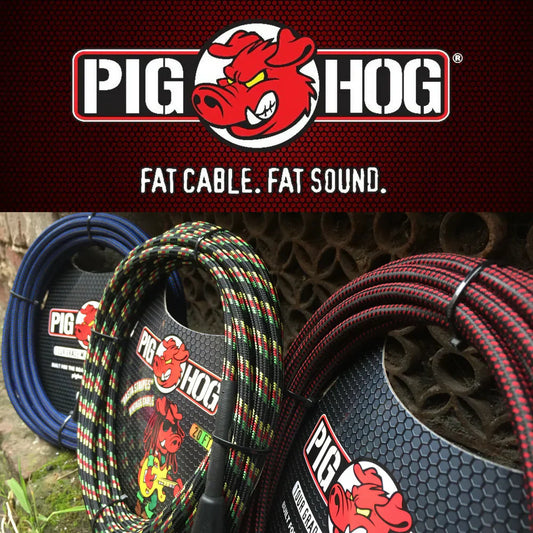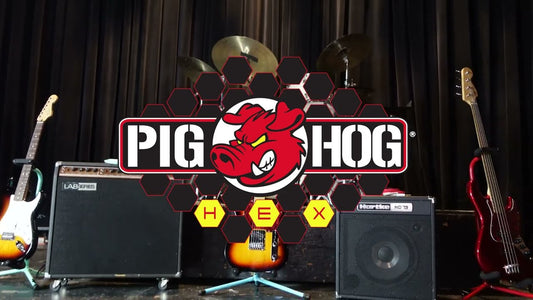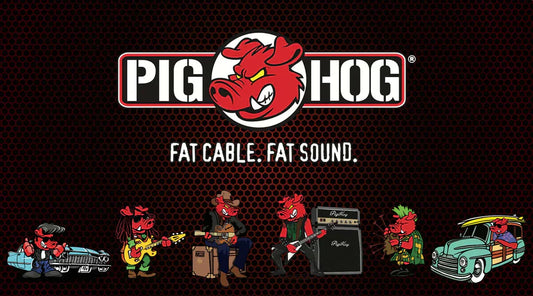Every musician knows the frustration of a bad cable—buzzing sounds, sudden dropouts, or a tone that just feels lifeless. The truth is, your cable is a critical part of your signal chain, and investing in the right one can make a huge difference in your sound and performance. Pig Hog Cables have earned a strong reputation among musicians for their durability, clarity, and reliability. But with so many options available, how do you choose the right one for your needs?
This Pig Hog Cables buying guide will walk you through the main instrument cable types, help you understand the importance of length, explain shielding technology, explore connector styles, and recommend the best picks for different music genres.
Understanding Cable Types (Instrument, XLR, Patch)
Before you even think about length, shielding, or connectors, you need to know which type of cable fits your setup. Pig Hog offers several types, each designed for a specific purpose.
Instrument Cables
These are the most common and are used to connect electric guitars, basses, keyboards, and other instruments to amplifiers or pedalboards. Pig Hog’s instrument cables are known for their heavy-duty jackets and ultra-low noise design. They come in different lengths and connector configurations to suit different playing styles.
Best for: Guitarists, bassists, and keyboard players who need clean, reliable signal transmission.
XLR Cables
An XLR cable is typically used for microphones, mixers, and certain studio gear. Pig Hog’s XLR models feature thick shielding and strong locking connectors, making them ideal for live performances where stability is crucial.
Best for: Vocalists, audio engineers, and anyone connecting professional-grade microphones or PA systems.
Patch Cables
Patch cables are short cables used to connect pedals on a pedalboard or link gear in a studio rack. Pig Hog patch cables are flexible, space-saving, and designed to keep your signal chain clean without adding unwanted noise.
Best for: Musicians with pedal-heavy setups or those needing short connections in the studio.
If you’re not sure which type you need, think about your signal path from start to finish—every connection point should have the right cable for the job.
Length Matters: How to Pick the Right Size
Cable length isn’t just a matter of convenience—it can directly affect your sound.
Shorter Cables Preserve Tone
The longer a cable is, the more resistance and capacitance it adds, which can slightly roll off high frequencies. For guitarists who want to preserve every bit of brightness, keeping cable runs short can make a noticeable difference.
When You Need Longer Runs
If you’re playing on a big stage or need to move around freely, a longer cable might be worth the trade-off. Pig Hog offers lengths up to 30 feet for instrument cables and even longer for microphone cables.
Balancing Mobility and Tone
Most guitarists find that 10–15 feet offers a sweet spot between freedom of movement and tone preservation. For pedalboard setups, you might use multiple short cables instead of one long run to maintain clarity.
Pro Tip: If you need a long run but want minimal tone loss, consider using a high-quality buffer pedal along with your Pig Hog cable.
Shielding & Noise Reduction Features
One of the biggest factors in cable quality is shielding—the protection that keeps outside electrical interference from messing with your signal. Pig Hog uses multiple shielding methods in their cables to ensure noise-free performance, even in challenging environments.
Braided Shielding
Provides durability and strong protection against interference, making it ideal for live gigs where cables may be stepped on or moved frequently.
Spiral Shielding
Offers flexibility while still reducing noise, perfect for pedalboard patch cables or studio setups that need more maneuverability.
Foil Shielding
Excellent for blocking high-frequency interference, often found in microphone and specialty cables.
The more shielding a cable has, the better it will perform in noisy environments—such as clubs, venues with neon lighting, or near other electronic devices. Pig Hog’s extra-thick jackets also add a layer of durability, ensuring that the shielding inside stays intact even after heavy use.
Connectors: Straight vs. Right Angle
Choosing between straight and right-angle connectors isn’t just about looks—it’s about practicality and fit.
Straight Connectors
These are the most common and work well when plugging directly into the front of an amp or a top-mounted guitar jack. They provide a secure connection and are less likely to put strain on the cable in most setups.
Best for: Guitars with side-mounted jacks, amp connections, and studio gear.
Right Angle Connectors
These are ideal for guitars with top-mounted jacks or pedalboards where space is tight. A right-angle plug can reduce the chance of accidental unplugging and keep your setup looking clean.
Best for: Pedalboards, top-mounted jacks, and cramped stage setups.
Many Pig Hog cables are available with either connector type, so you can choose the one that best suits your setup—or mix and match for different connection points.
Best Picks for Different Music Genres
Pig Hog makes a wide range of cables, and the “best” choice often depends on your playing style and genre. Here’s a quick breakdown to help you decide:
Rock & Metal
Go for a Pig Hog Vintage Series Instrument Cable—the heavy-duty jacket can take the punishment of live shows, and the robust shielding keeps your high-gain tone clean. A 15- or 20-foot length is ideal for energetic stage movement.
Jazz & Blues
Opt for a shorter cable (10–12 feet) to preserve tonal warmth and clarity. Pig Hog’s Gold Series offers premium sound with a smooth, rich response perfect for clean tones.
Funk & Pop
Choose a flexible cable that works well with pedals. Pig Hog patch cables are excellent for pedal-heavy funk setups, while their standard instrument cables maintain punchy highs for slap bass or bright guitar tones.
Singer-Songwriters
If you’re using both guitar and vocals, pair a Pig Hog Instrument Cable with a Pig Hog XLR Cable for your mic. Consistent quality across both ensures a clean mix.
Electronic & Studio Producers
Use Pig Hog balanced cables for connecting synths, mixers, and studio monitors to avoid hum and maintain pristine signal quality.
Why Pig Hog Cables Are a Smart Investment
Musicians often underestimate how much a good cable impacts their sound and performance. With Pig Hog, you’re getting:
-
Durability that can withstand years of gigs and travel
-
Noise-free performance in challenging environments
-
Lifetime warranty for long-term peace of mind
-
Options for every setup, from bedroom practice to world tours
They’re not the cheapest option, but the reliability and sound quality make them a cost-effective choice in the long run.
Making the Final Choice
When choosing your Pig Hog cable, consider these quick steps:
-
Identify the type (Instrument, XLR, Patch) based on your gear.
-
Decide the length that gives you mobility without sacrificing tone.
-
Pick your shielding level if you play in noisy environments.
-
Choose the connector type based on your instrument and setup.
-
Match your genre to the right series for your style.
You can explore our full Pig Hog Cables collection in blue for detailed specs, customer reviews, and recommendations based on your setup.
Your Sound Deserves the Best
Every musician’s sound is unique, and the cable you choose plays a crucial role in delivering that sound to your audience—whether that’s in a small coffee shop or a packed stadium. Pig Hog Cables give you the confidence to play without worrying about signal loss, noise, or failure mid-performance.
If you’re ready to take your tone and reliability to the next level, check out our best-selling Pig Hog Cables in blue today and find the perfect match for your setup.



